Sweet Daddy D’s Seafood Gumbo uses a thick, dark roux, the Trinity and rich seafood stock. Crabs, oysters and shrimp, are added towards the end, bringing the flavor of Louisiana’s seafood bounty. A small amount of okra contributes its unique flavor but doesn't dominate the other ingredients. This gumbo reminds me of growing up in New Orleans when enjoying fresh crabs, shrimp and oysters was a family affair. Seafood Gumbo warms the soul and is the flavorful essence of South Louisiana that is at once familiar and unique for anyone that has grown up here.
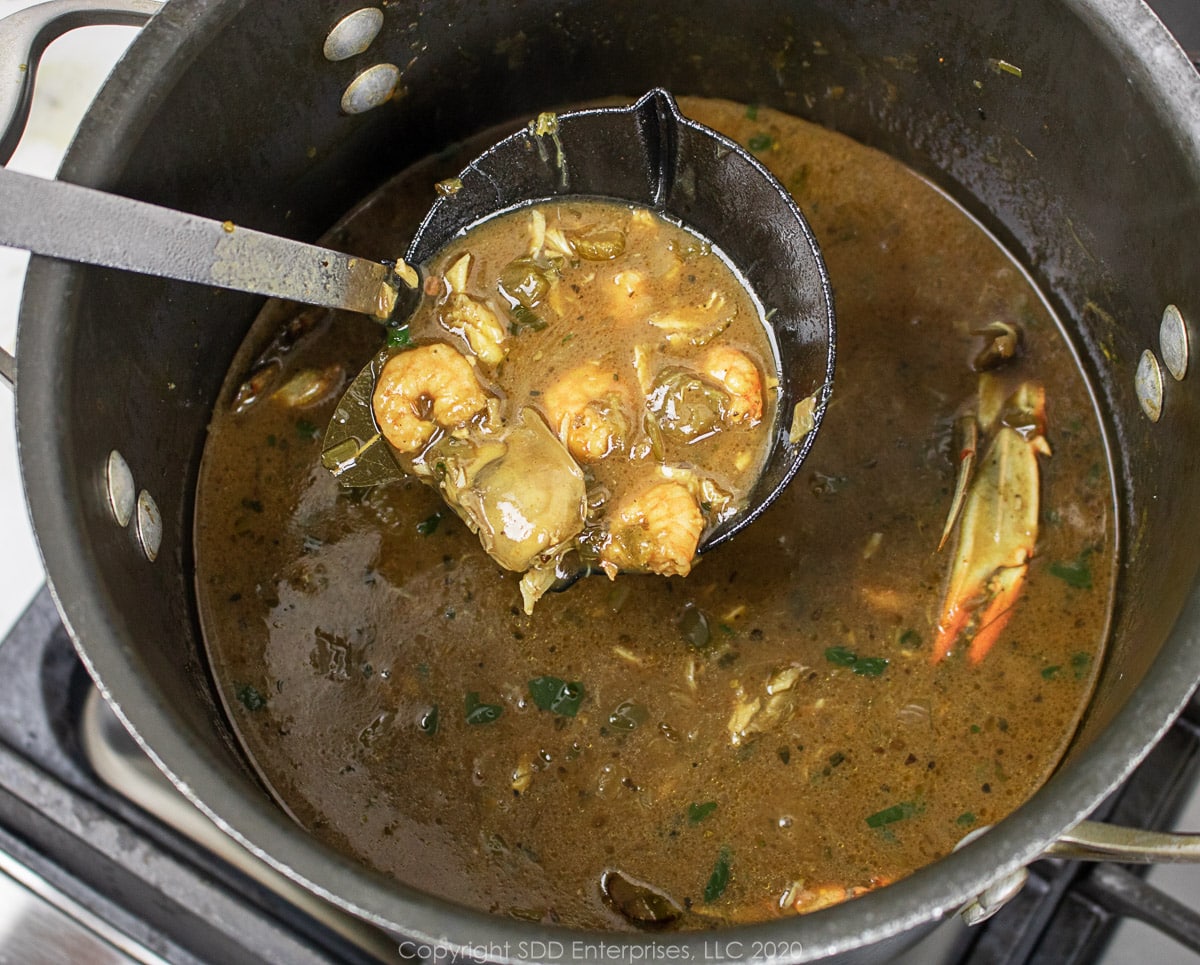
This post is not sponsored, but you will find affiliate links on this page. As an Amazon Associate, I earn from qualifying purchases. The price you pay as a consumer does not change, but I may make a small commission based on your purchase.
If you want to just skip to the recipe, click the "Jump To Recipe" button above or the Recipe link below and you’ll go right there without having to scroll through my article.
What are the basics of gumbo?
Gumbo is a rich and flavorful soup-like dish usually thickened with a roux, okra or filé and usually includes some combination of seafood, chicken and smoked meats. Like no other dish, it represents the cultural amalgamation of South Louisiana, so it's no surprise that there isn’t much agreement about what should and should not go into a gumbo. Each gumbo you’re served will be unique because of the regional and cultural influences that guide the recipes. As you may expect, Cajun gumbo will be a little more rustic, thick and hardy and generally made with chicken and sausage. Creole gumbo may reflect more variety in ingredients and include seafood as well as meats.
The one thing to understand is that there are no hard and fast rules, but there are some basics:
- Start with a roux. Take your time. Make sure you don’t undercook it, but don’t burn it either.
- Use the Trinity to help build the base. These are Cajun and Creole foundation vegetables of yellow onions, bell peppers and celery.
- Use stock instead of water as you want to layer in the flavors with every step. Water doesn’t contribute anything.
- If you are using meats, brown them first to intensify the flavors and share the flavorful rendered fat will all the other ingredients. Add them towards the beginning of the process.
- Add any seafood at the end of the process. Seafood will be influenced by the other flavors and add their unique dimension, but most seafood cooks very quickly and only needs a short time.
All this being said, I remind you that there are no rules, these are just basics. If you think politics are heated, try to tell a Creole cook what she should put in her gumbo. Tomatoes? Thick dark roux or light thin roux? Okra? File’? Mix seafood with meat? These are just a few of the variables you will encounter.
Here’s What You Need
It's important to use fresh, high-quality ingredients. Some of the ingredients are perfectly fine frozen: shrimp, gumbo crabs and okra. If you don't have time to make your own Homemade Seafood Stock, you can substitute commercial seafood stock or chicken stock.
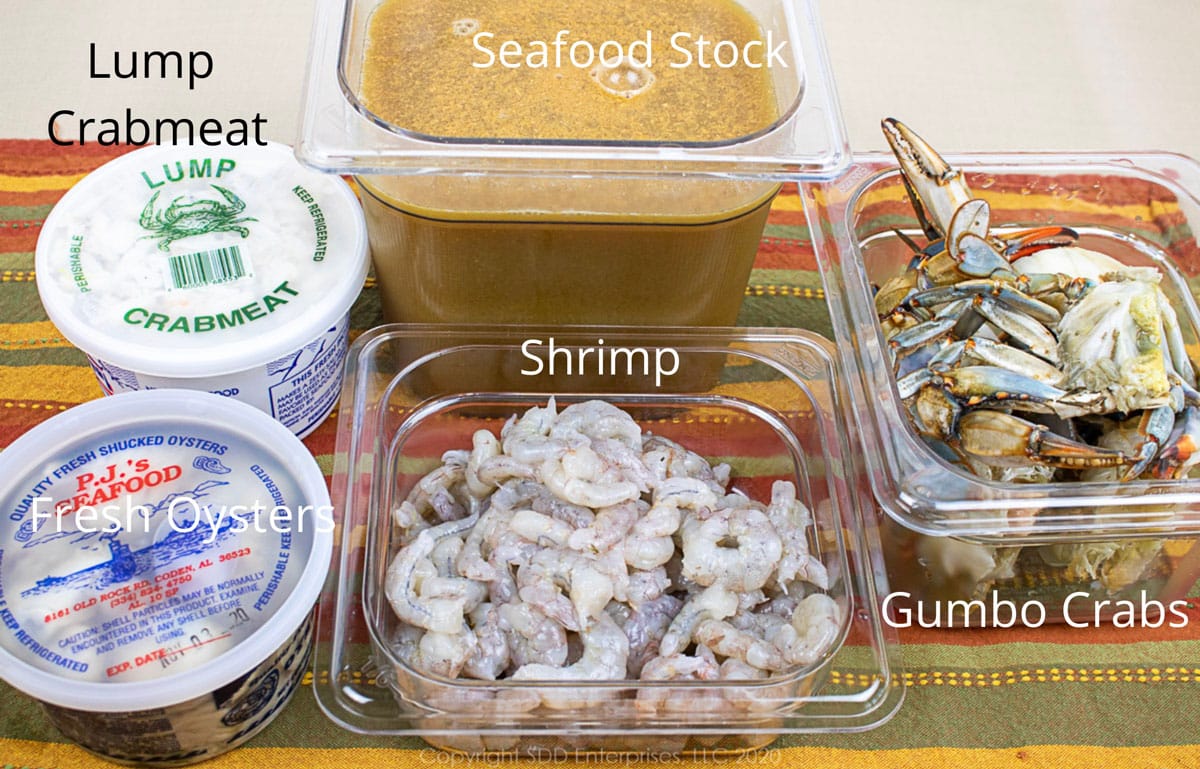
Homemade Seafood Stock really elevates this recipe. If you're interested in making your own, check out Sweet Daddy D's recipe:
How do you get the right size shrimp? Learn how to know all about sizing shrimp by reading my article What Size Shrimp Do I Need?
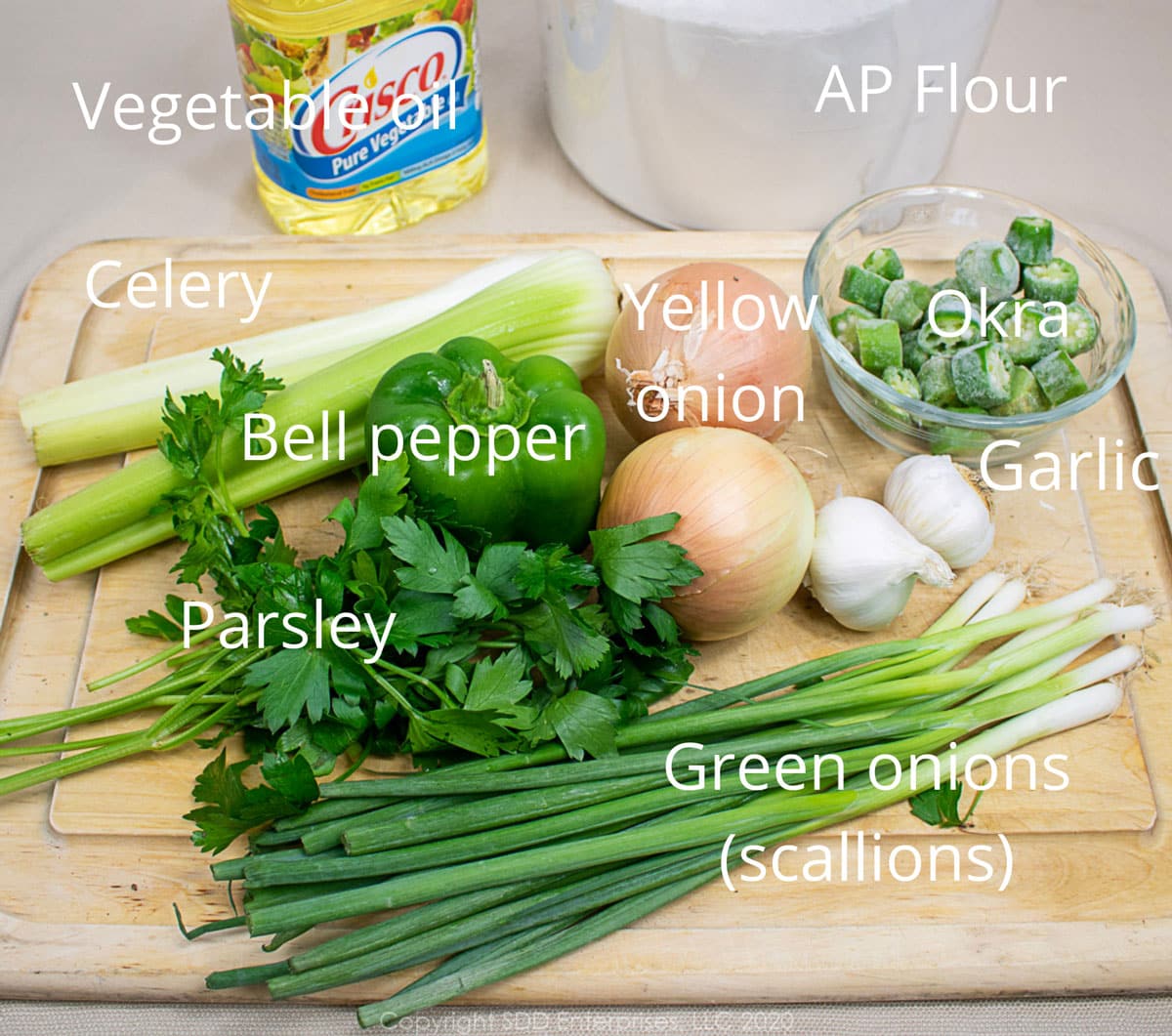
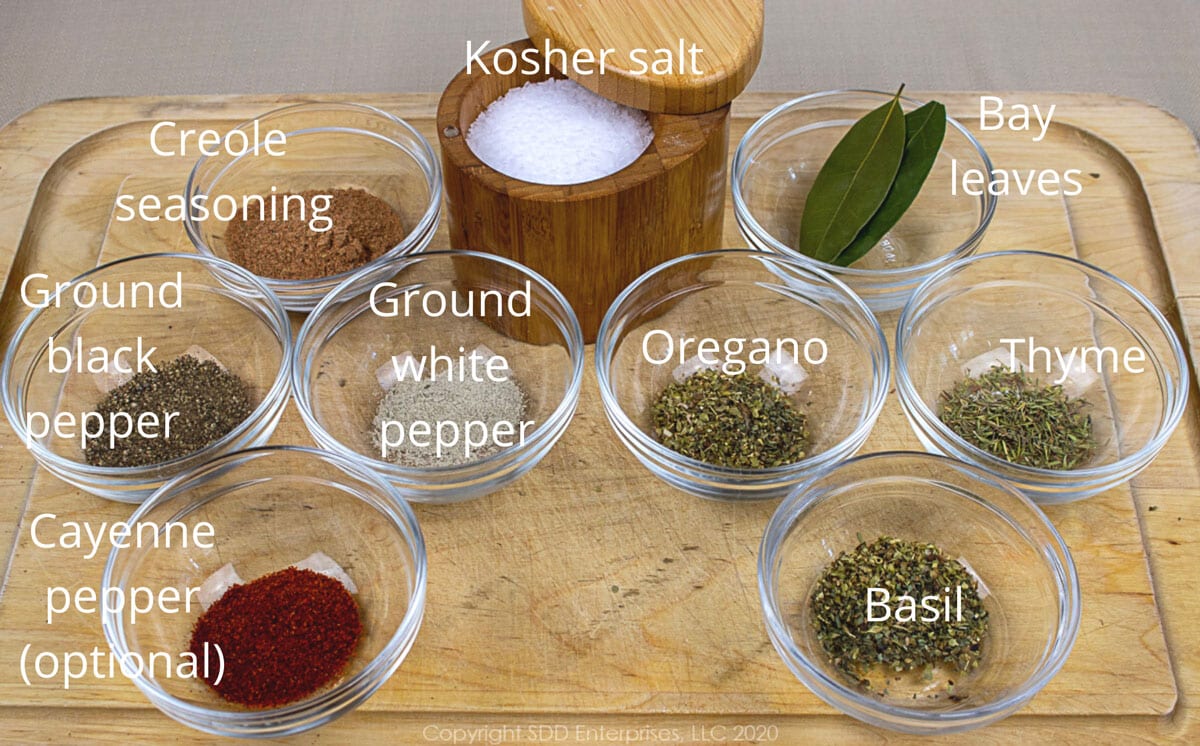
Equipment
Here is some of the equipment I used to prepare this recipe:
This post is not sponsored, but you will find affiliate links on this page. As an Amazon Associate, I earn from qualifying purchases. The price you pay as a consumer does not change, but I may make a small commission based on your purchase.
8 Quart Stockpot, Cast Iron Dutch Oven, Cutting Board, Cambro Prep Bowls, Glass Prep Bowls, Chef's Knife, Measuring Cups, Measuring Spoons, Rex Brand File Powder, Zatarain's Brand File Powder, Commercial Seafood Stock, Commercial Chicken Stock.
Here’s What You Do
First...you have a beer. Making a gumbo is fun and even more so when you are prepared. The idea is to get in the right frame of mind and have all the ingredients prepped so all you have to do is assemble the recipe. Mise en place...prepare the ingredients and prepare the cook. Sit down and sip a beer while you read the recipe all the way through. Make sure you have what you need and you know what you’ll do with each ingredient. When you’re ready, start by prepping the individual ingredients.
Prep the ingredients
Peel, devein and rinse the shrimp in cold water. Pat them dry with a kitchen towel or paper towel, sprinkle with some Creole seasoning and set them aside.
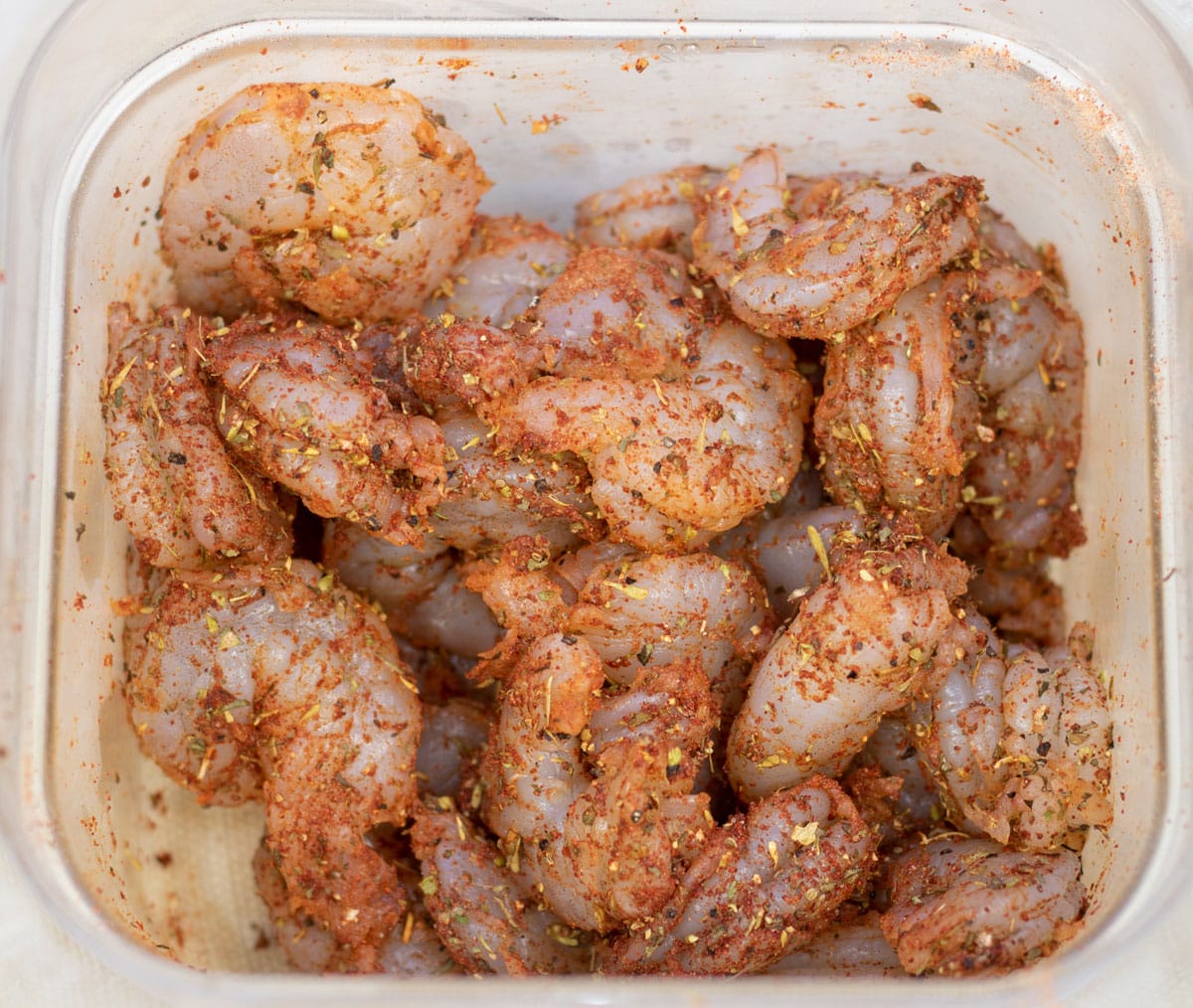
Cut the gumbo crabs in half (leave the claws and legs attached to each half), sprinkle some creole seasonings over them and set them aside.
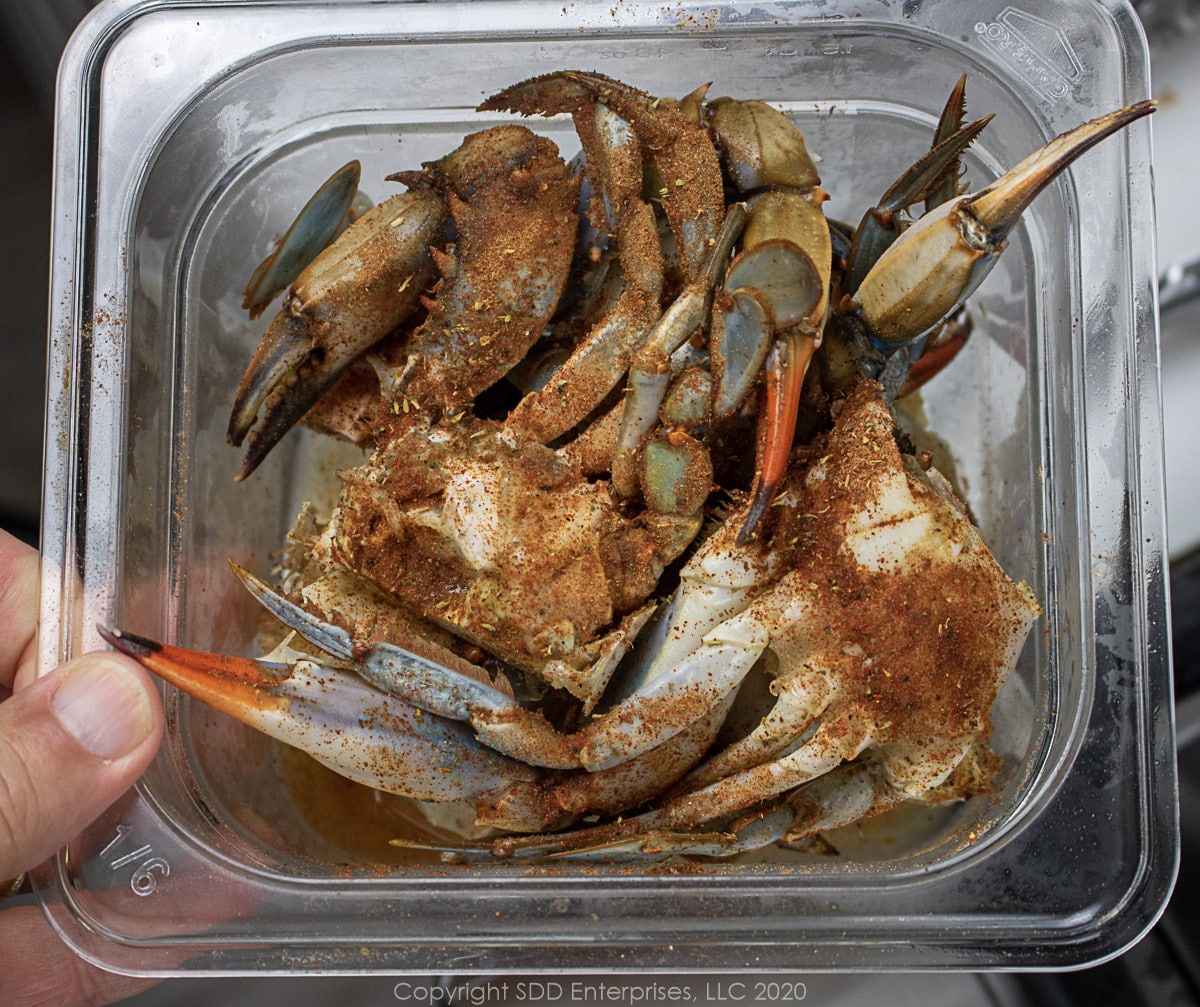
Chop and measure all the remaining ingredients: place the Trinity in one prep bowl together; in separate prep bowls or measuring cups place the garlic, green onions, parsley, okra, stock, vegetable oil and the flour. Mix the Herb and Spice Blend and set that aside.
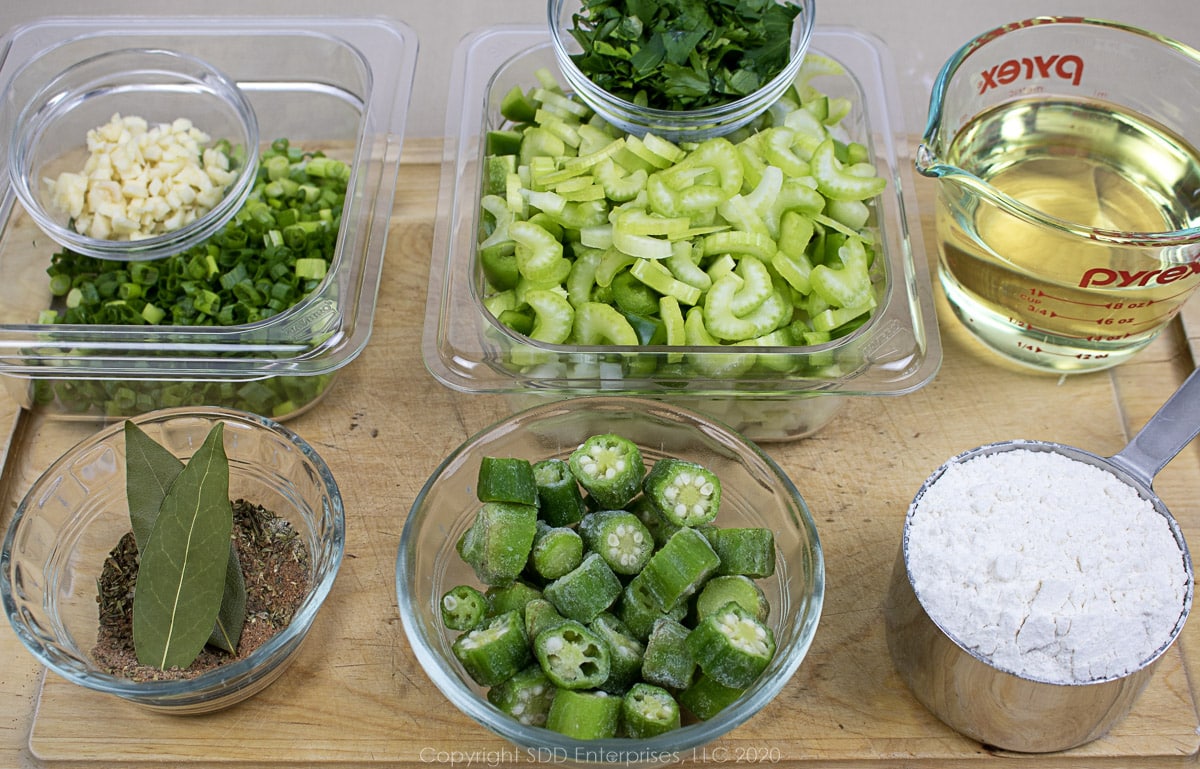
Set up for a two-pot process
Place the seafood stock in a large stockpot and set over low heat to warm while you cook the roux and vegetables. Set a large cast-iron Dutch oven over medium-high heat.
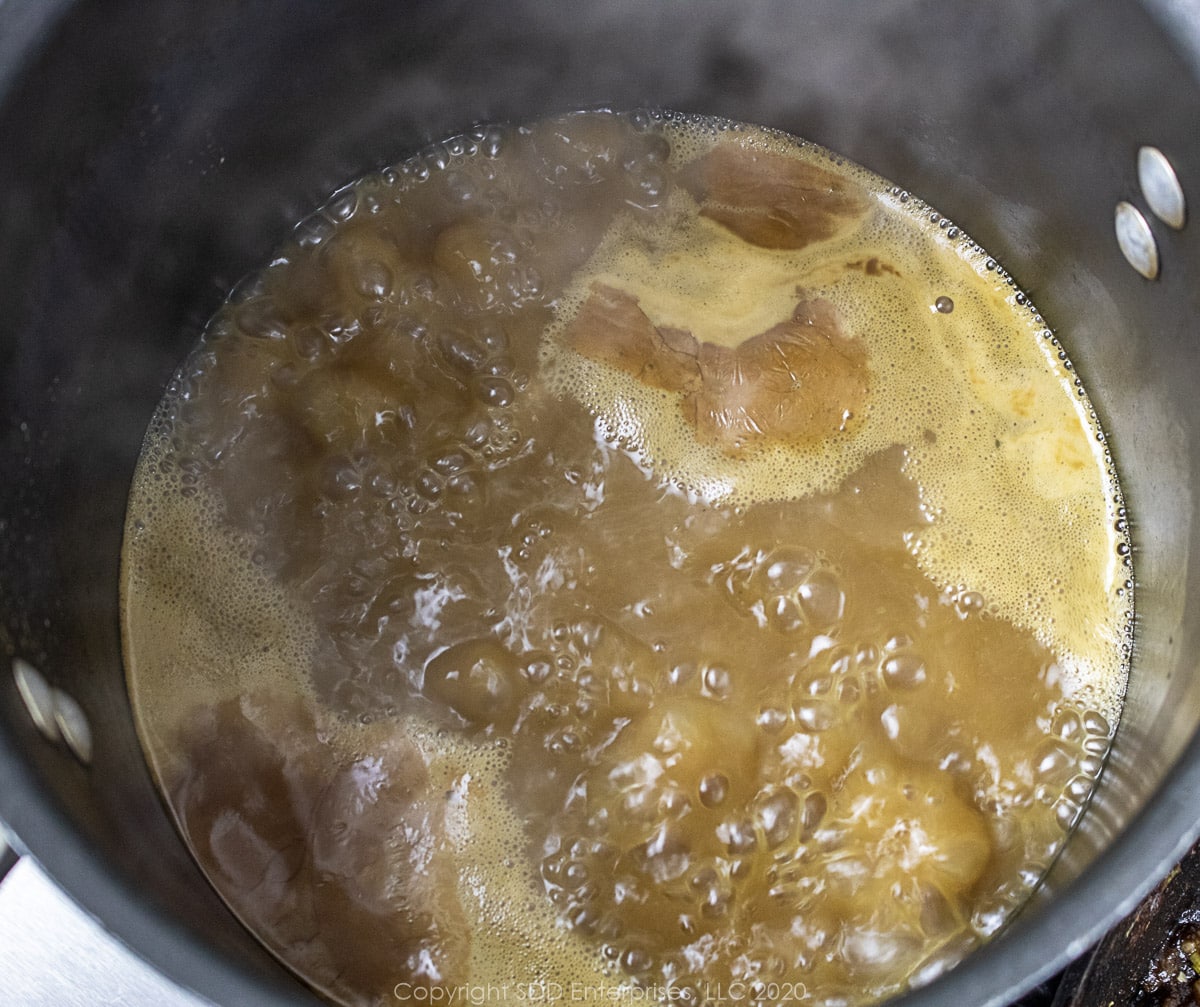
Make a dark roux
Add the vegetable oil to the Dutch oven. When the oil starts to shimmer, sprinkle in the AP flour and whisk constantly to make a smooth dark roux. You want something like dark chocolate, so this should take about 10 minutes.
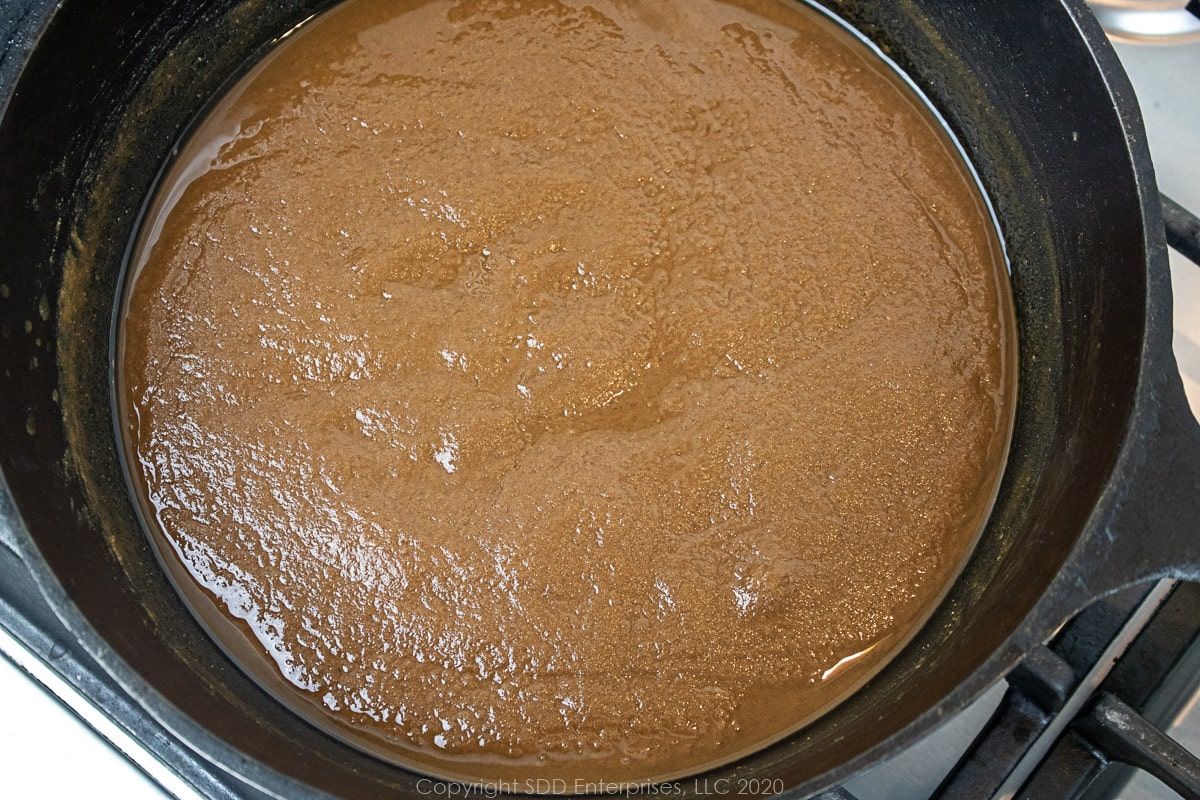
A note on this particular roux:
This roux looks very dark in the photos. I was going for a dark chocolate-colored roux and that's what I got. A roux will continue to cook after you add the vegetables so it's always a good idea to remove the roux from the heat at that time to slow the process. Once everything is incorporated and the heat has diminished, return the pan to a medium heat and continue. Make sure you taste the roux as you go. If it tastes burned throw it out. A burned roux will ruin your recipe, so have another beer and start over.
Cook the vegetables in a roux
When the roux is the color you want, remove the Dutch oven from the heat. Add the Trinity and stir continuously for about 5 minutes, then place it back over medium heat. The roux will continue to cook once you add the Trinity, so this process helps slow that down. Stir almost continuously until the Trinity starts to caramelize, which should take another 10 to 15 minutes.
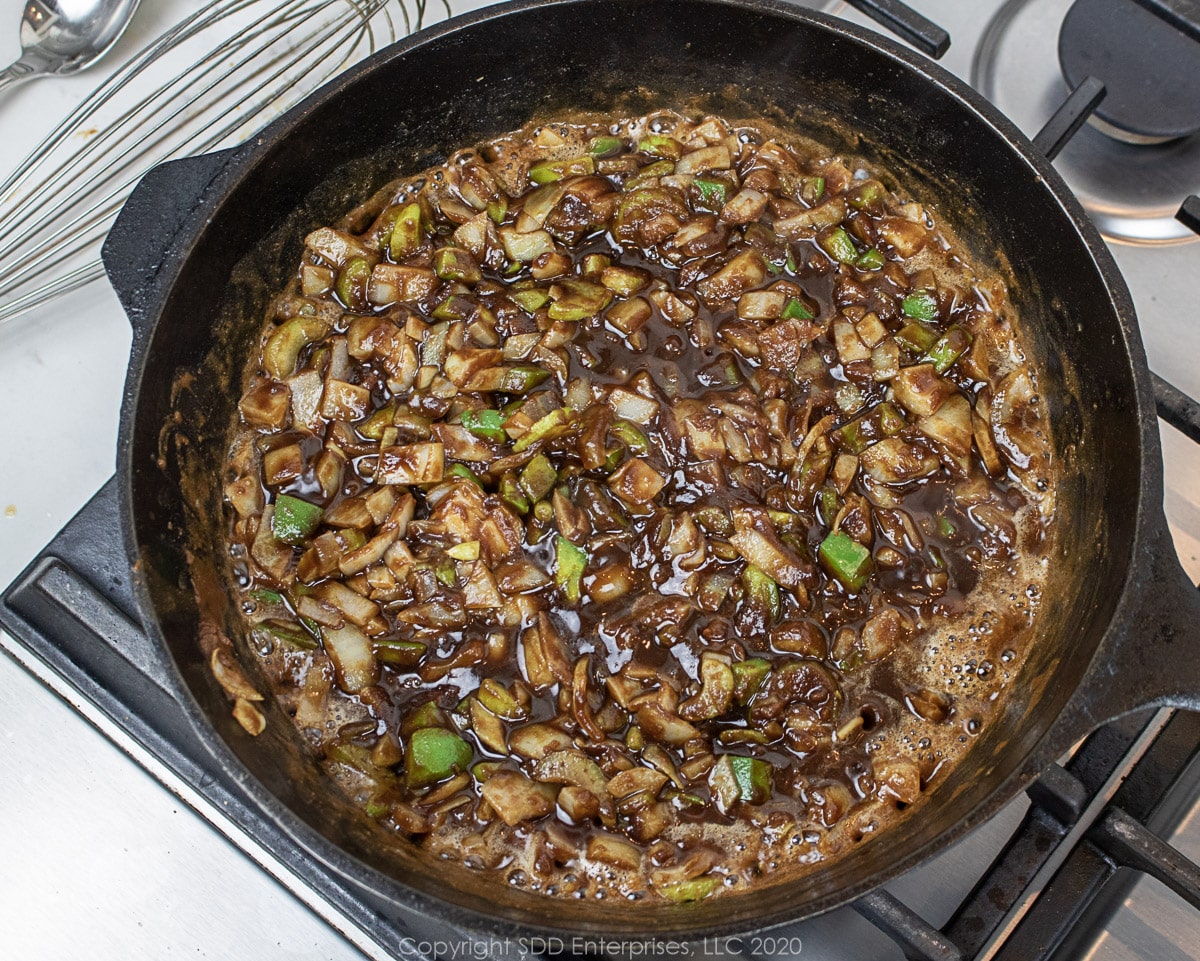
Add the okra and saute another 5 minutes.
Mix the okra into the roux mixture and continue to stir and sauté for about 5 minutes.
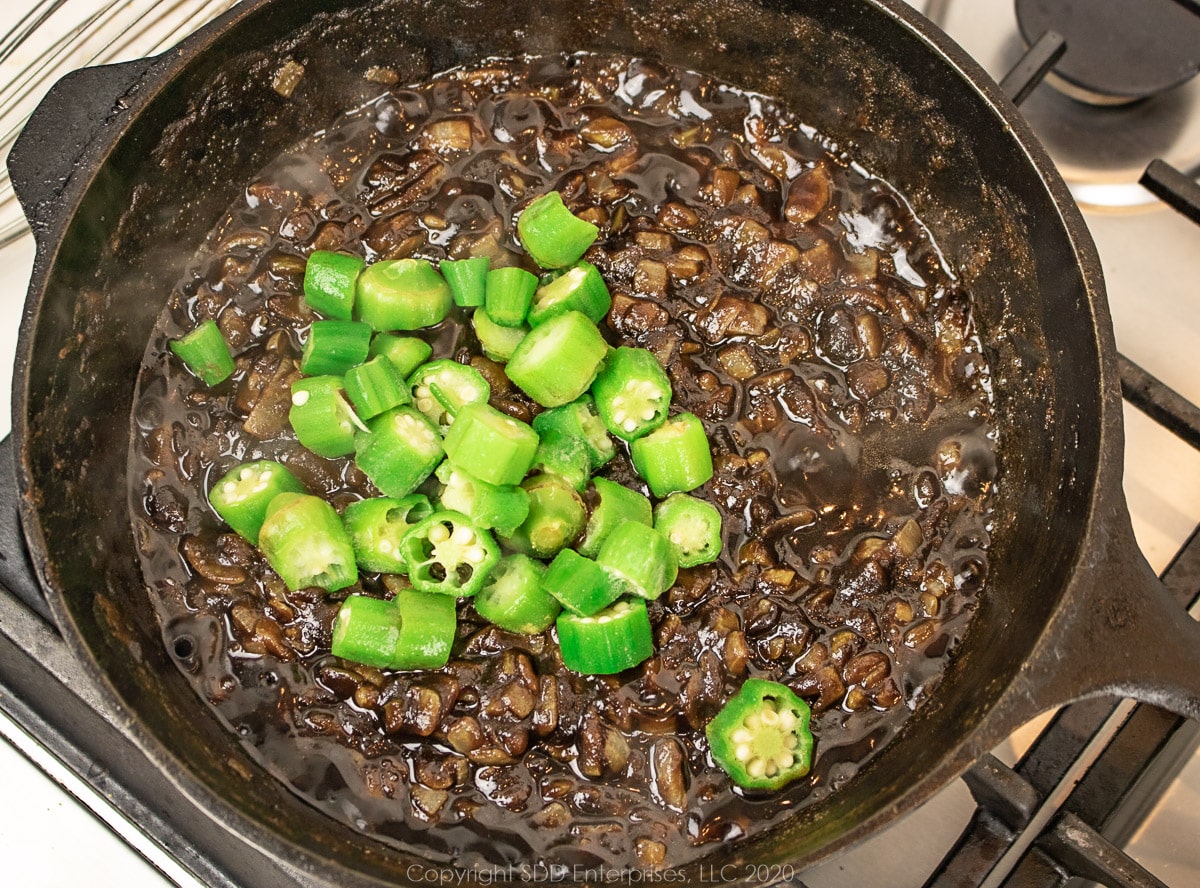
Add the aromatics
Add the garlic and about half of the Herb and Spice Blend. Mix everything together well until you can smell the garlic, about 3 minutes.
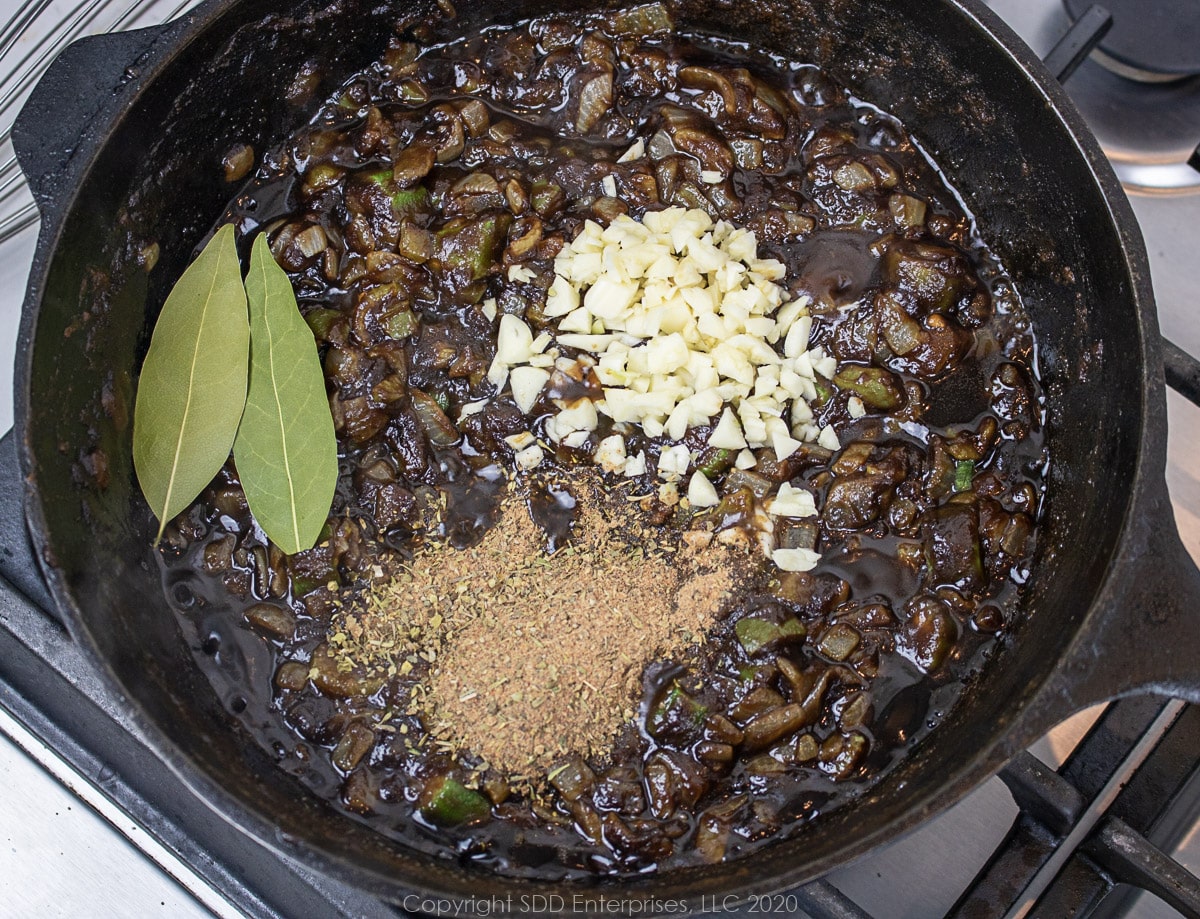
Add the green onions and saute another 5 minutes. Remove the Dutch oven from the heat while you bring the stock to a heavy boil.
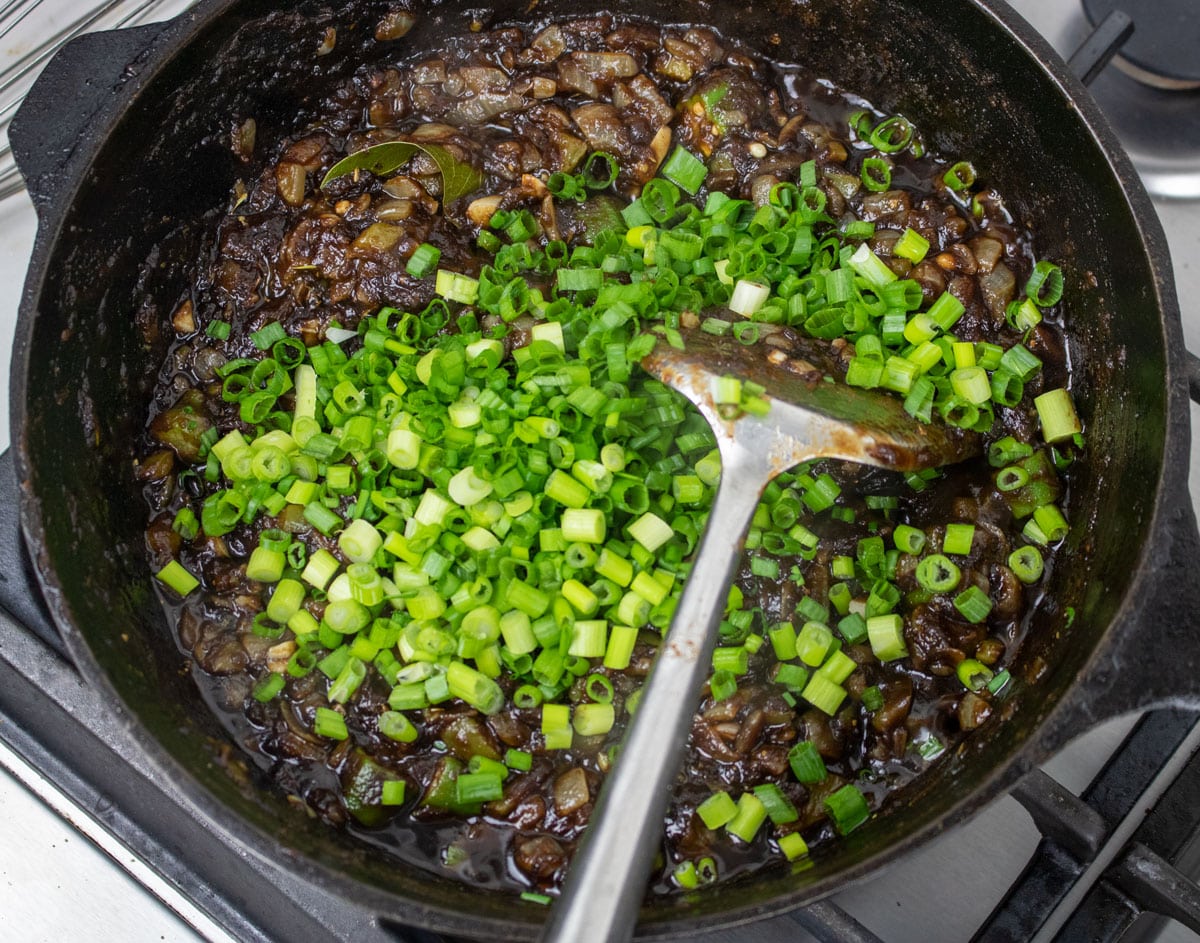
Combine the roux mixture with the stock
Increase the heat under the stockpot and bring the stock to a heavy boil. Using a slotted spoon, combine the roux mixture with the boiling stock, one spoonful at a time. Stir each spoonful until it is fully incorporated into the stock before repeating the process. Don’t rush, this will take between 5 and 10 minutes.
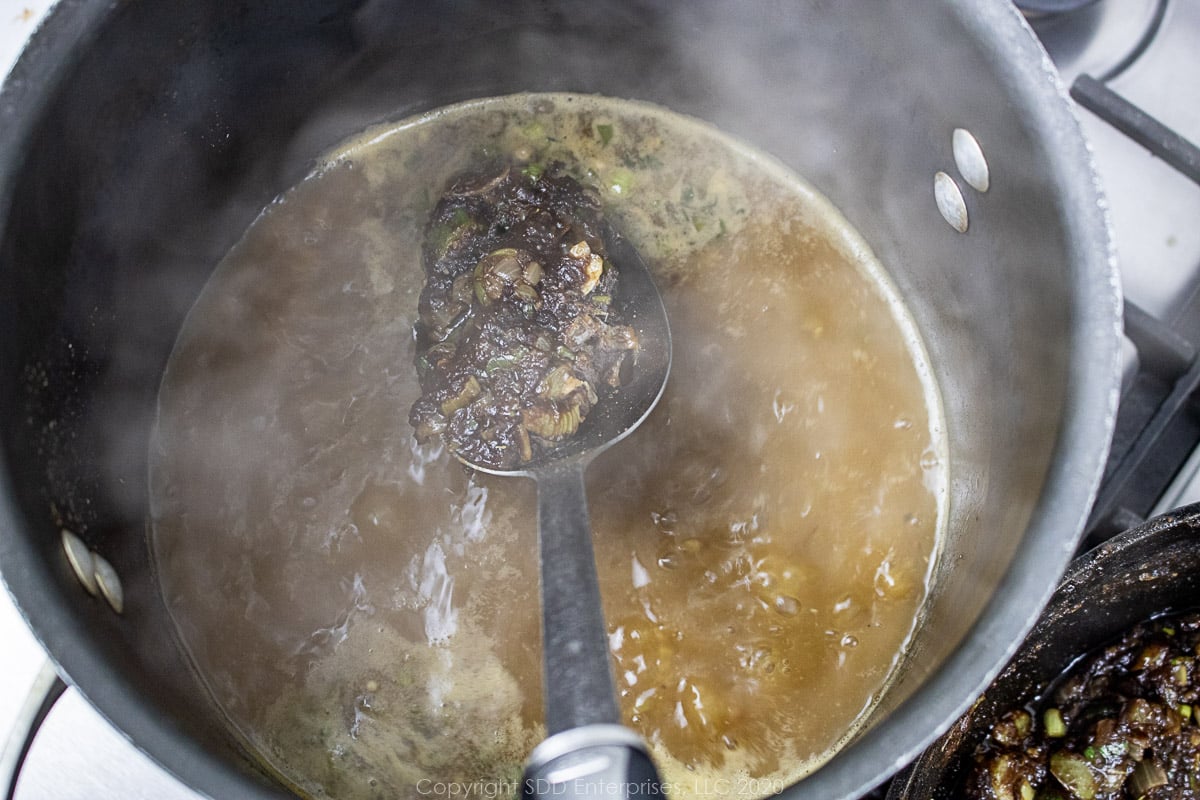
Simmer the gumbo
When all of the roux-mixture has been incorporated into the stock, reduce the heat slightly to maintain a steady, low boil for about 10 minutes, uncovered. This lets all the flavors introduce themselves. After 10 minutes, lower the heat to a low simmer. Cover the stockpot and maintain that low simmer for about 1 hour, stirring occasionally so it doesn’t stick to the bottom.
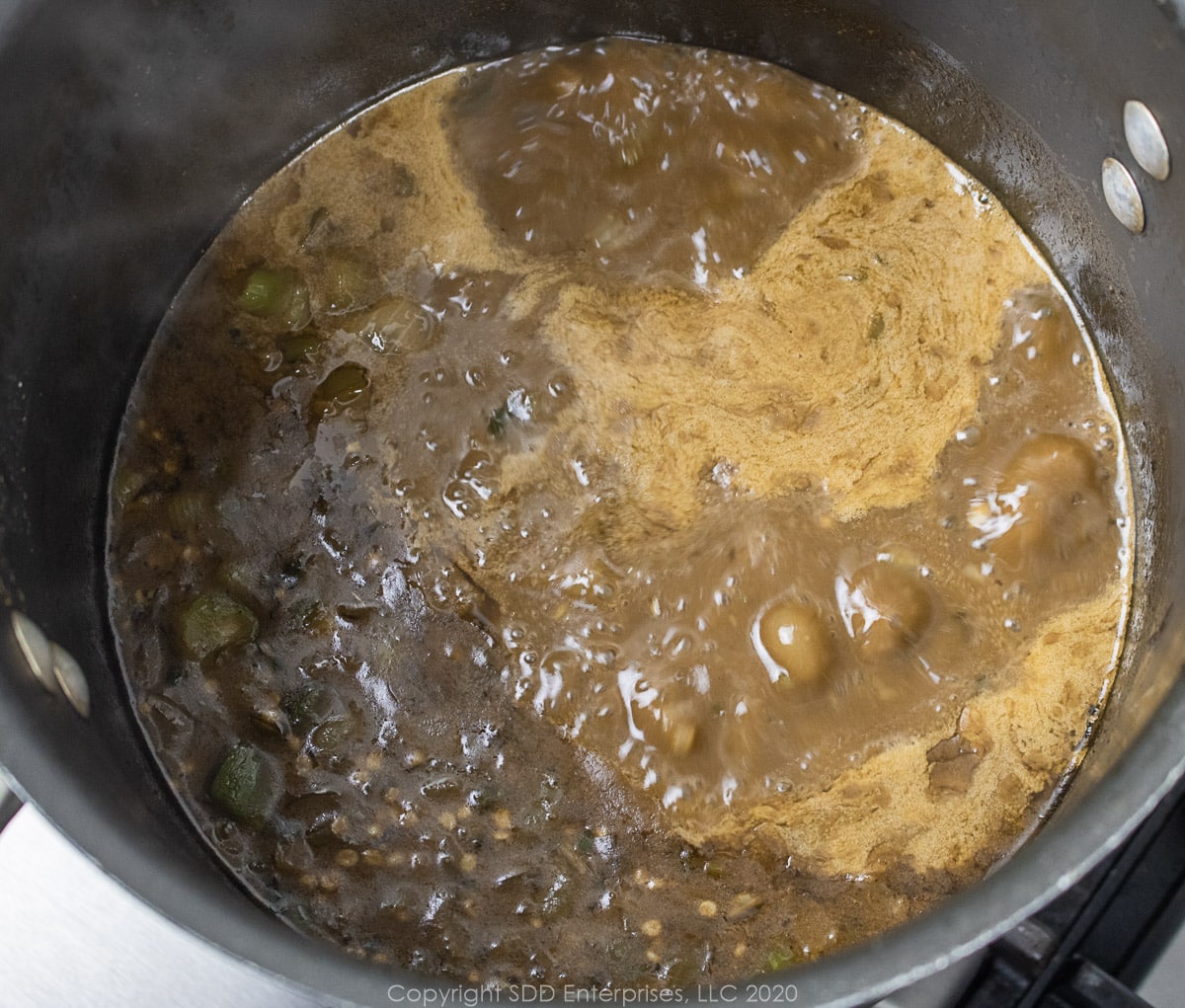
Add the seafood
After an hour, remove the lid, add the gumbo crabs and stir well. Replace the cover and simmer another 15 minutes.
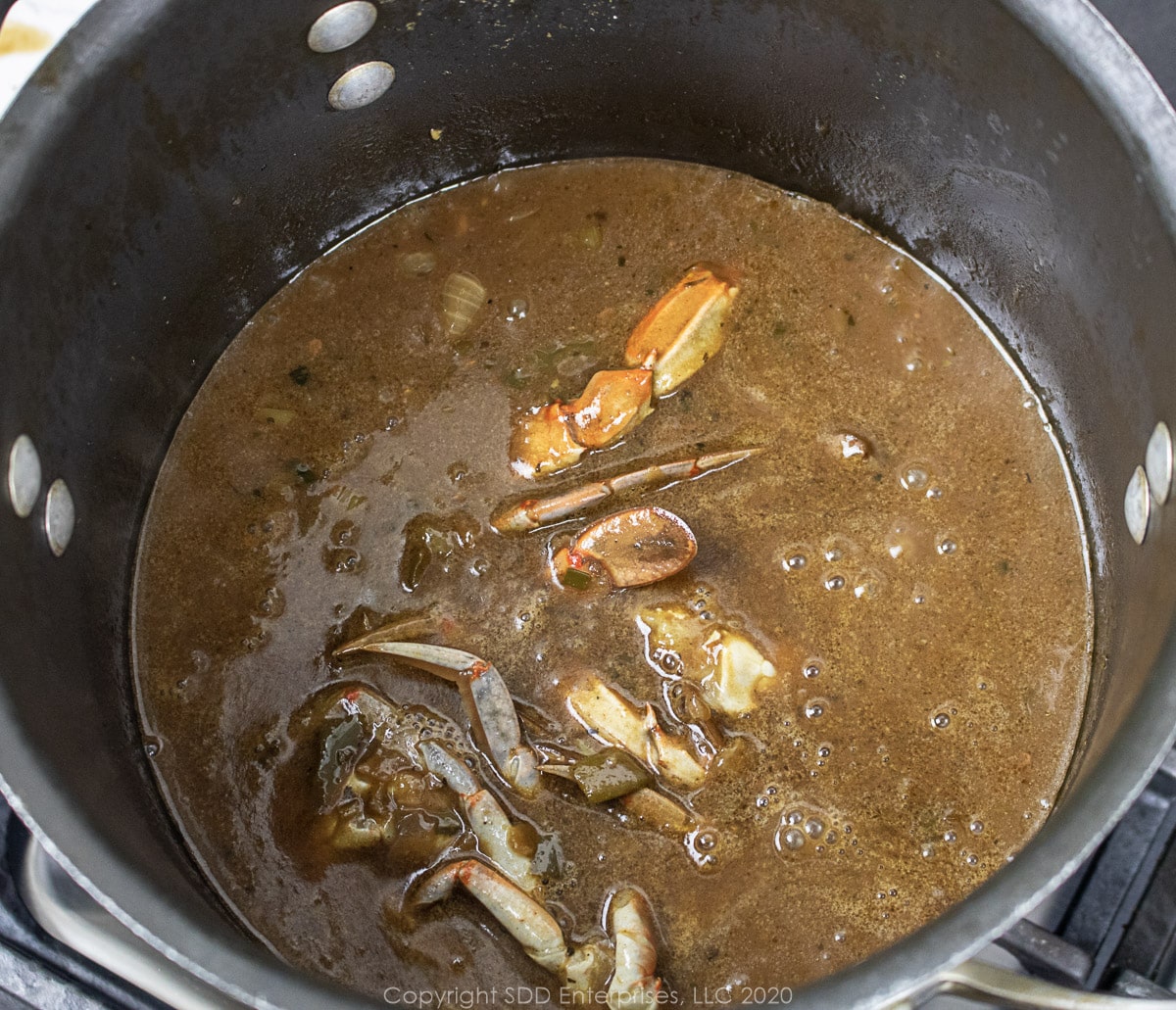
Remove the lid and increase the heat to a medium boil before adding the seafood, which will lower the temperature in the stockpot considerably. Slowly add the oysters (with their juice), lump crabmeat and shrimp by hand, a little at a time. Stir the pot in between each addition and let the gumbo return to a boil before adding more. Adding the seafood in this manner will take about 10 minutes, but you’re adding a handful of love with each dose.
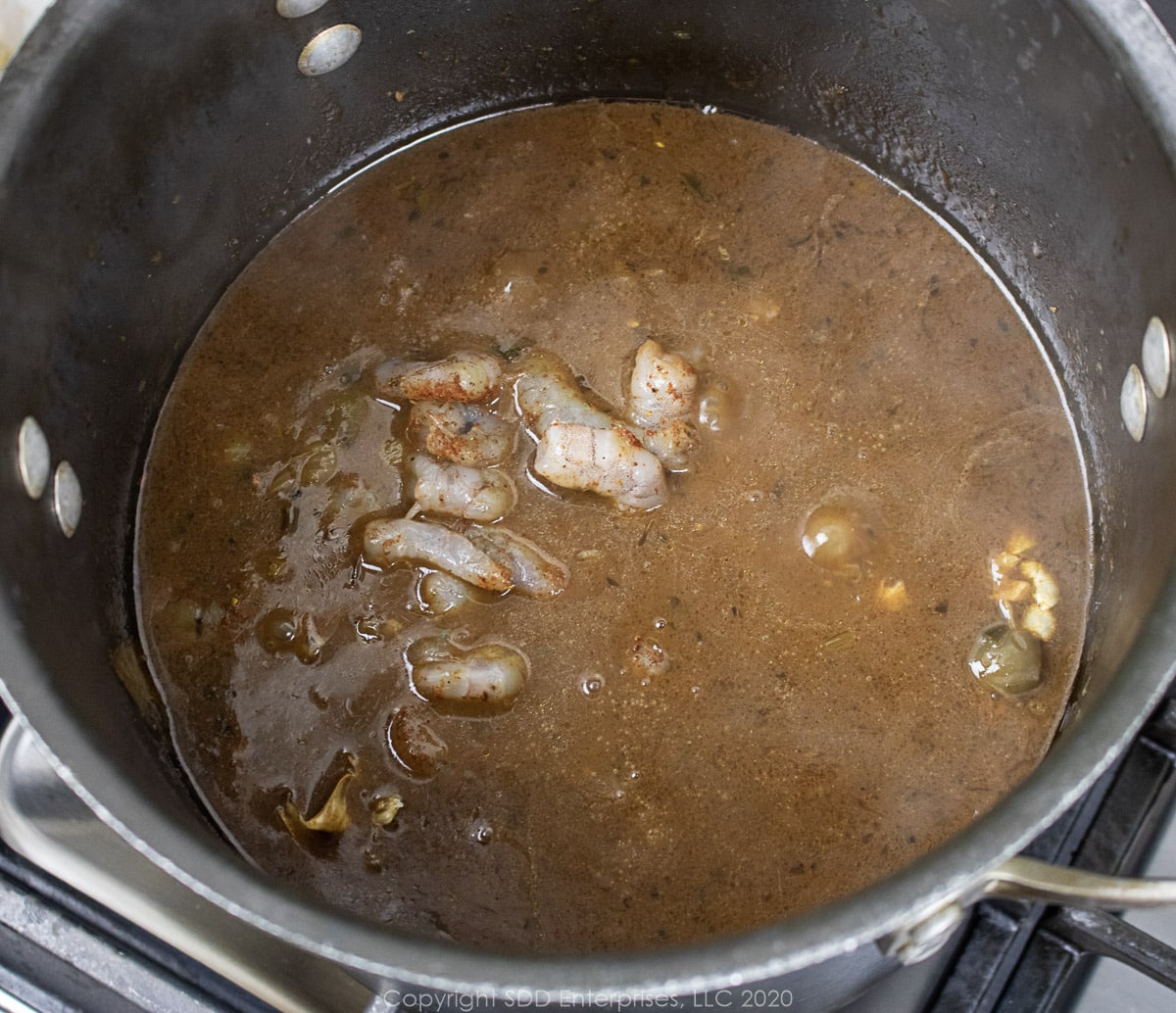
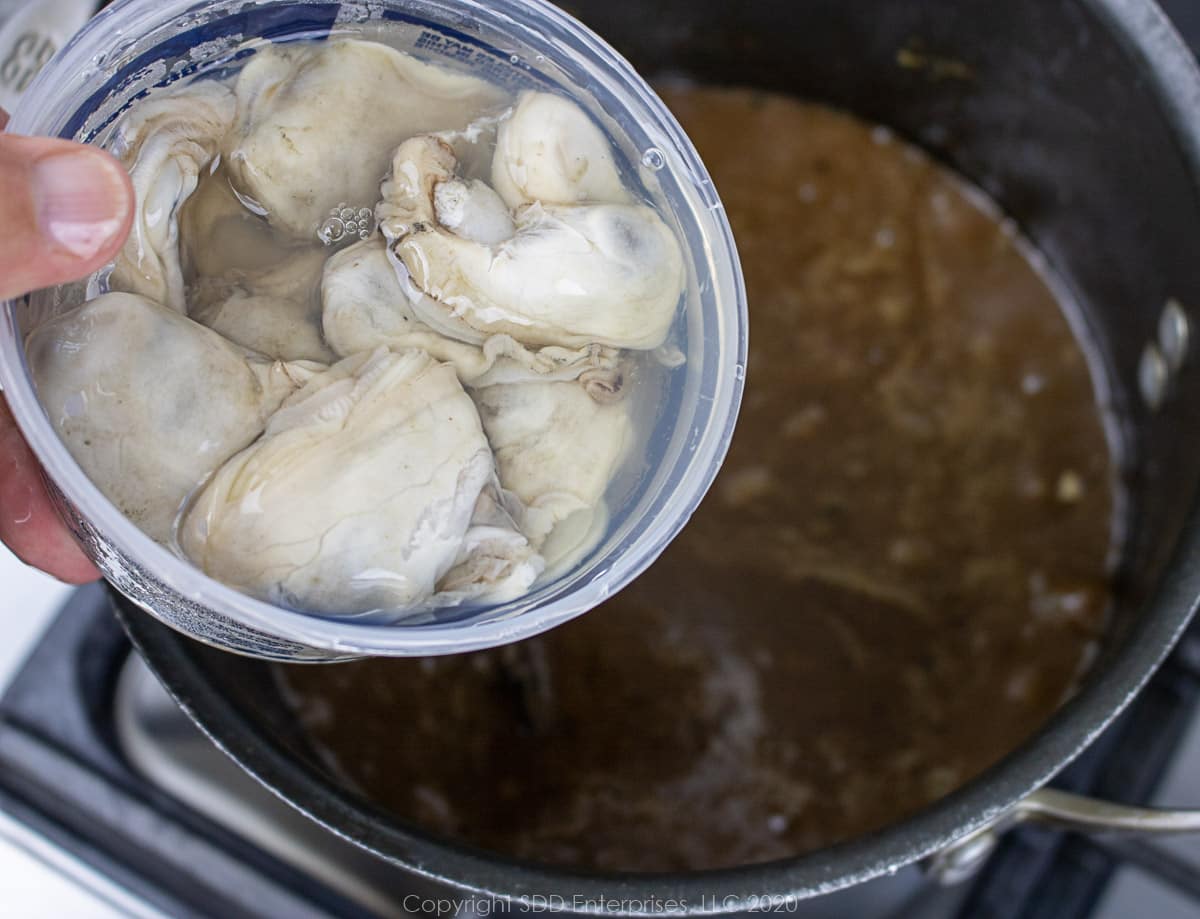
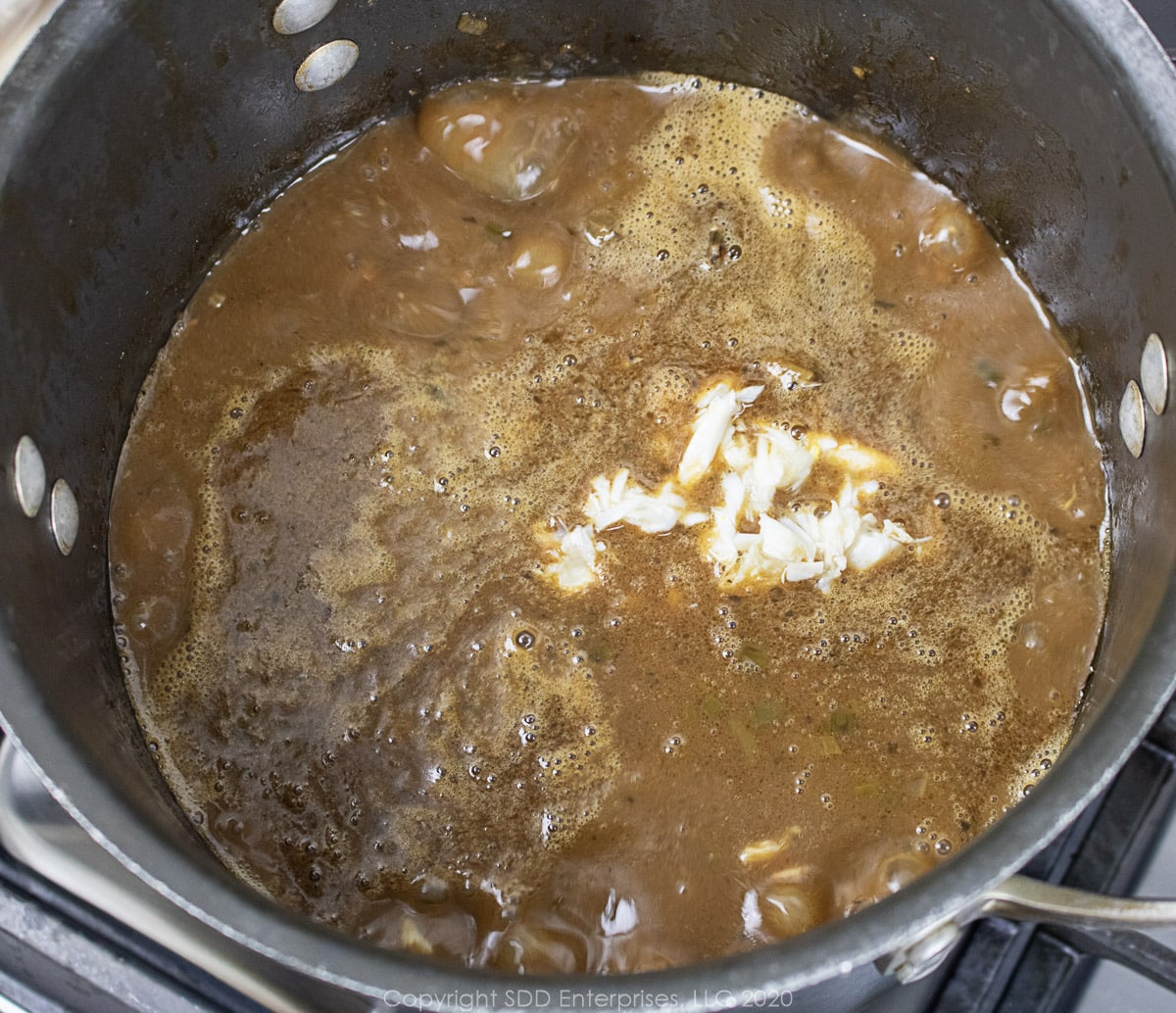
Once all the seafood has been added, throw in the parsley and more Herbs and Spices. Stir well, lower the heat and continue to simmer for about 15 minutes, covered.
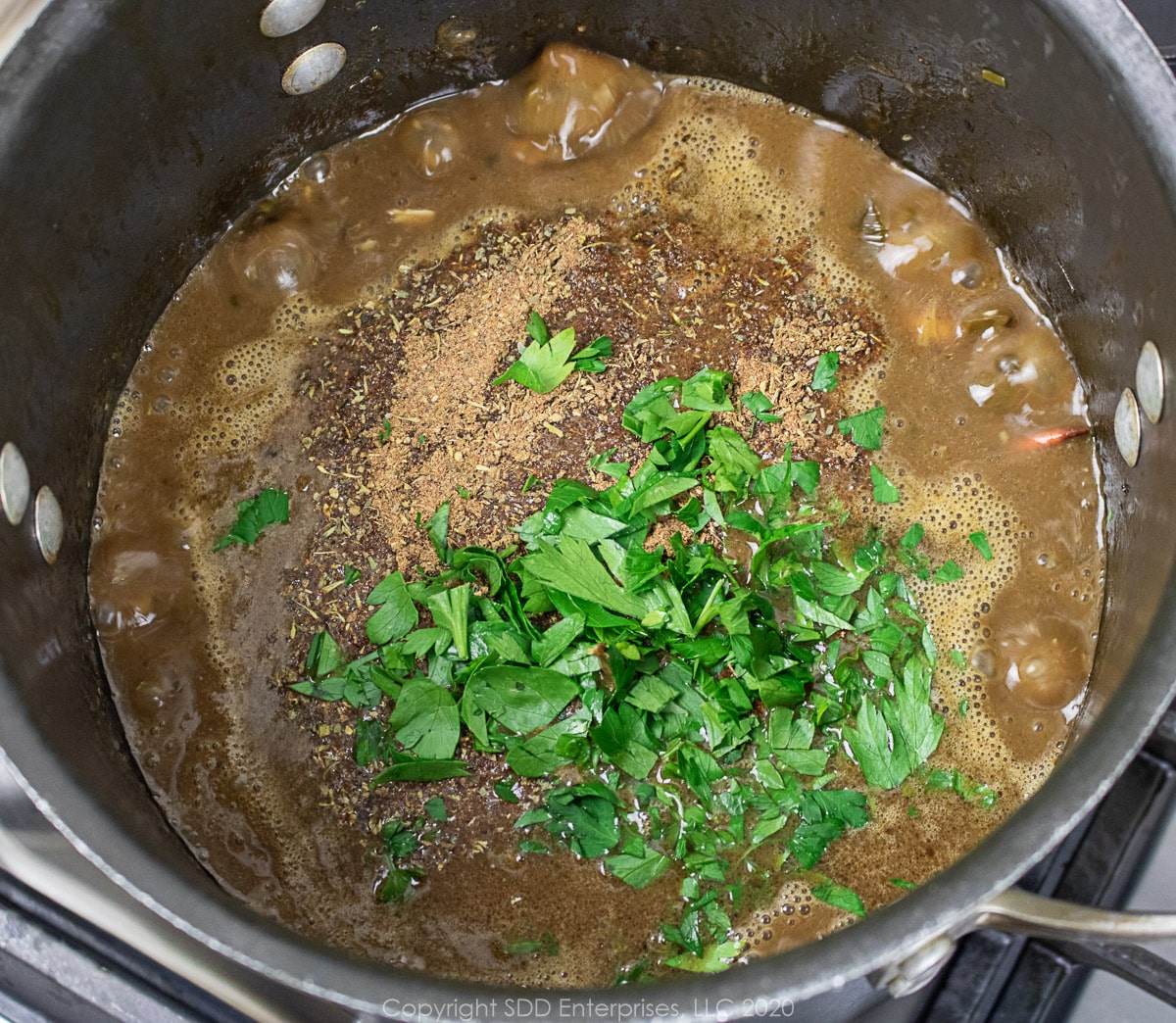
Remove the gumbo from the heat. Serve with cooked white rice.
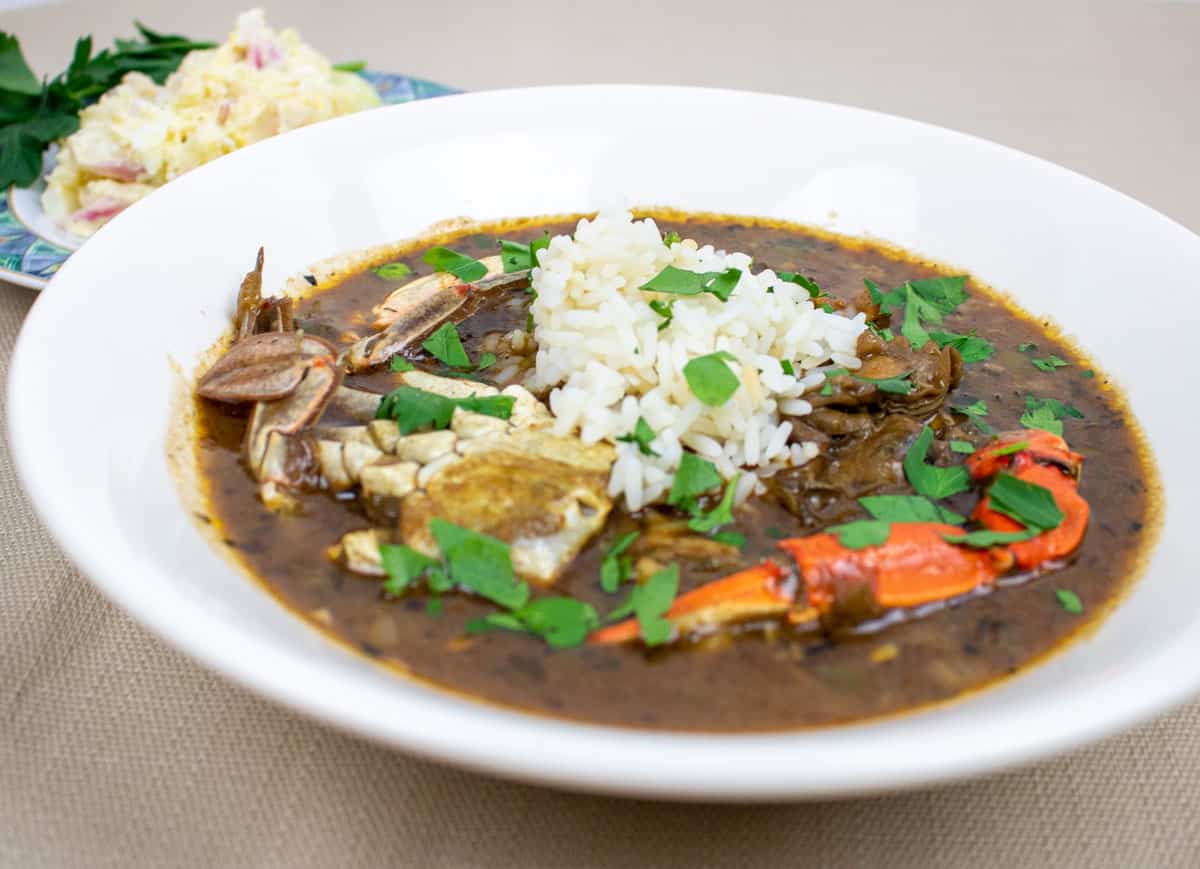
Hints and Tips
If you haven’t been raised eating gumbo, you may have some questions about how to serve it. Gumbo is akin to soup, it's not like rice and gravy. Don’t pile up a bunch of rice and dribble a little gumbo over it. Eat it like soup, in a bowl. Gumbo is generally served with cooked, white rice. How much rice is a matter of personal preference, but the rice is either placed in the bowl and gumbo ladled on top, or the gumbo goes in first and the rice is scooped on top. Some restaurants (and this is a good way to do it) serves the rice on the side so you can spoon in as much as you want or not include it at all. Make sure you have a nice bottle of Tabasco Hot Sauce. To me, a few dashes of Tabasco on this Seafood Gumbo is the perfect finisher!
Again, the regional influences come into play here. Potato Salad is a very common side with gumbo and some folks (mainly from German influence) even add the potato salad directly to the gumbo in lieu of rice. A nice green salad, like my Sensation Salad, is, well, sensational with gumbo. Gumbo can be served as an appetizer or part of a larger meal, but it’s almost mandatory to serve some crispy french bread.
“Gumbo crabs” are primarily used for seasoning in stock and gumbo. To me, they are an essential ingredient in Seafood Gumbo. They are hard-shell crabs with the top shell removed and the cavity with the gills cleaned out. The legs and claws are still attached. These are generally smaller crabs that would not yield good lump meat but pack all the flavor of larger crabs. They are sold frozen in seafood markets. Check out Cajungrocer.com for some (I am not an affiliate of Cajungrocer.com but I know they provide quality products and services.
No, you can use frozen shrimp if that’s what you have. I recommend using lots of small to medium-size shrimp (check out my short article What Size Shrimp Do I Need? to learn about shrimp sizes). Using fresh shrimp is a little more work but definitely worth the trouble. Besides the freshness, the shells and heads can be used to make a wonderful stock.
My favorite is jumbo lump, but besides being harder to find, it can break the bank. Lump crabmeat is perfect for this recipe but backfin or even claw meat will also provide the flavor for an extremely enjoyable Seafood Gumbo.
Commercial seafood stock can be substituted for homemade. Don’t just use plain water because the stock is an essential layer of flavor that I believe is necessary. You can also substitute commercial chicken stock.
Filé (also called filé powder or gumbo filé) is dried and ground sassafras leaves. Its use is almost synonymous with gumbo as a thickener and for its unique flavor. Filé's use as an ingredient in South Louisiana began originally with the Choctaw Indians and later adopted by the Acadians when they arrived in Louisiana. Filé can be added to the recipe as a thickener (if doing so, remove the gumbo from the heat before adding) or sprinkled on top after cooking or at the table. To some in South Louisiana, it ain't gumbo until you add the filé. Want to give it a try? Amazon has Zatarain's Pure Ground Gumbo Filé and Rex Gumbo Filé. Both brands are popular in South Louisiana.
Gumbo is one of those dishes that tastes even better the next day. The key to maintaining quality is storing in airtight containers. You can refrigerate gumbo for about 3 or 4 days. Reheat the portions you want in a saucepan or the microwave to 165 degrees Fahrenheit. (Avoid reheating numerous times, this destroys the quality!) Gumbo will last about 4 to 6 months in the freezer, again if it’s stored in an airtight container. Make sure to leave some headroom for expansion when it freezes. Defrost it overnight in the fridge or in a bowl of cold water, which is changed every 30 minutes. Reheating is the same, stovetop or microwave. I do not recommend refreezing once it has been defrosted. For that reason, you may consider freezing in small quantities.
Try these other Gumbo Recipes from Sweet Daddy D:
If you make this recipe:
- Tell us about it in the Comments section below
- LEAVE A RATING ON THE RECIPE-worthy of 5-Stars?
- Questions or Comments? that’s the place!
- SIGN UP FOR OUR EMAIL UPDATES so you don't miss anything!
- Post a picture and share it with your friends on our Social Media:
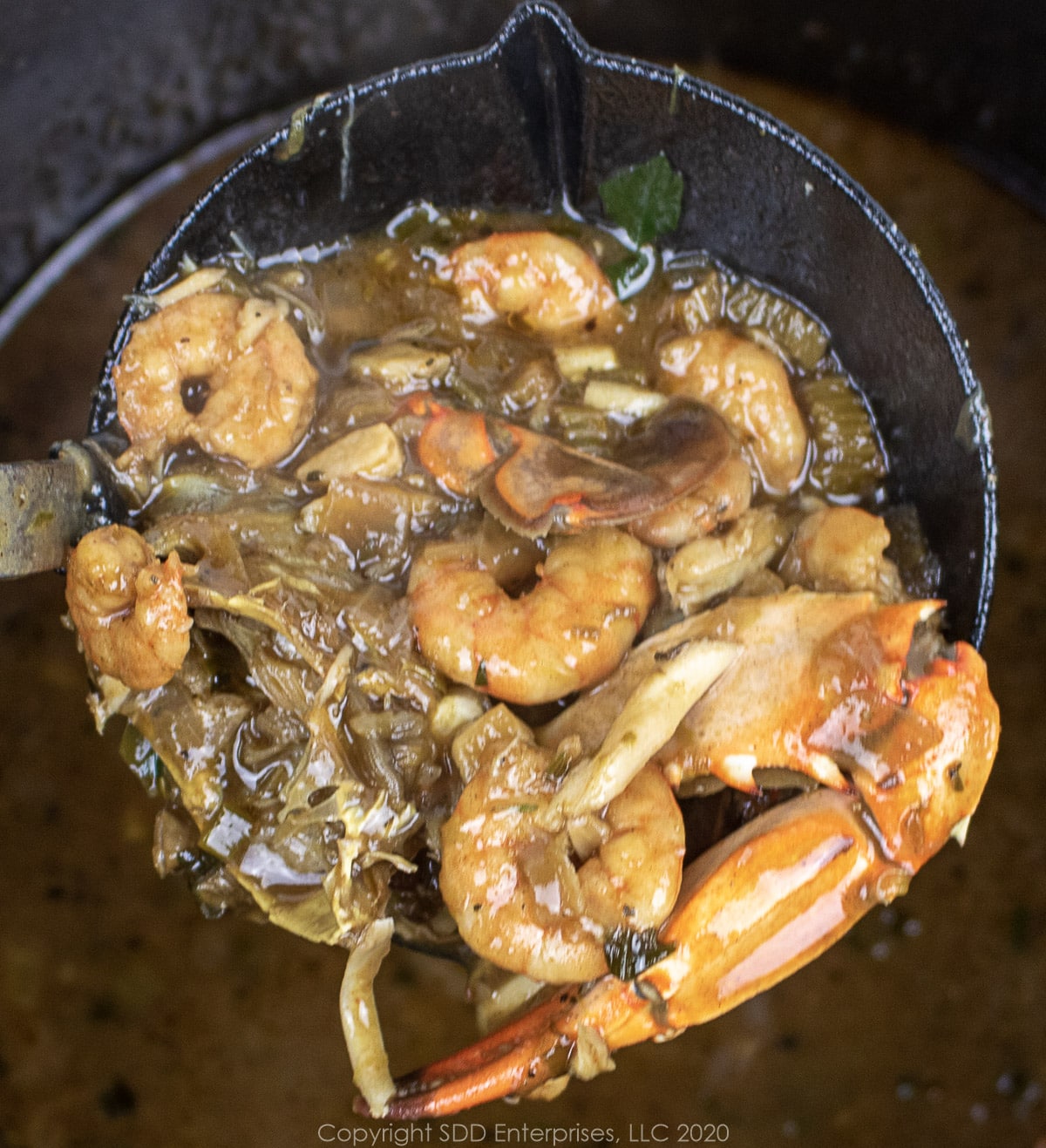
Yeah You Right!
Recipe
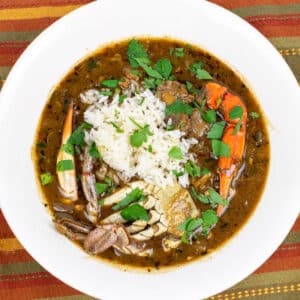
Seafood Gumbo
Here's What You Need
- 1 cup vegetable oil
- 1 cup AP flour
- 2 cups yellow onions chopped
- 1 cup bell pepper chopped
- 1 cup celery chopped
- 6 cloves garlic chopped
- 1 cup okra chopped
- 1 bunch green onions chopped
- ½ cup parsley chopped
- 8 cups seafood stock
Seafood
- 2 pounds shrimp
- 1 pound lump crabmeat
- 3 gumbo crabs
- 1 pint oysters
Herb and Spice Blend
- 2 teaspoon dry oregano
- 2 teaspoon dry basil
- 1 teaspoon dry thyme
- 1 tablespoon Creole seasoning plus some for the seafood
- ½ teaspoon white pepper
- ½ teaspoon ground black pepper
- ½ teaspoon cayenne optional
- 1 teaspoon kosher salt
- 2 bay leaves
Here's What You Do
- Peel, devein and rinse the shrimp. Pat dry and sprinkle with some Creole seasoning and set aside.
- Cut the gumbo crabs in half (head to toe) and sprinkle some creole seasonings over them and set aside.
- Chop the trinity and place it in one prep bowl. Chop the garlic, the green onions and the parsley and place them in individual prep bowls. Place the freshly chopped or frozen okra into a prep bowl. Mix together the Herb and Spice Blend and set aside. Measure the stock, vegetable oil and AP flour.
- Place the seafood stock in a large stockpot and set the heat to low.
- Place a cast iron dutch oven over medium heat.
- Add the oil and allow it to become very hot.
- Sprinkle the AP flour into the oil and whisk constantly to make a smooth dark roux. About 10 minutes
- Remove the Dutch oven from the heat and add the trinity (yellow onions, bell peppers and celery) to the roux and stir to combine. Once combined, return the Dutch oven to medium heat and stir regualrly until it starts to caramelize about 15 minutes.
- Add the okra and saute another 5 minutes.
- Add the garlic and about half of the Herb and Spice Blend, mix well until you can smell the garlic, about 3 minutes,
- Add the green onions and saute another 5 minutes.
- While that is simmering, bring the stock to a heavy boil in the stockpot.
- Remove the Dutch oven from the heat.
- Using a slotted spoon, desolve the roux mixture into the rapidly boiling stock, one spoonful at a time. Stir each spoonful until it is fully incorporated into the stock before repeating the process.
- When all of the roux-mixture has been incorporated into the stock, reduce the heat slightly to maintain a steady, low boil for about 10 minutes.
- Lower the heat to a low simmer. Cover the stockpot and maintain a low simmer for about 1 hour, stirring occasionally.
- Remove the cover and add the gumbo crabs and stir well. Replace the cover and simmer another 15 minutes.
- Increase the heat to a medium boil. Add the oysters with their juice, the lump crab meat and the shrimp. These should all be added by hand, a little at a time allowing the gumbo to return to a boil between additions.
- Once all the seafood has been added, continue to simmer for about 15 minutes.
- Remove the gumbo from the heat. Serve with cooked white rice.

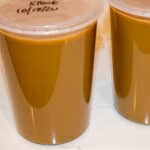

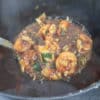

J &S Busby
This was ABSOLUTELY the best flavored with just the right amount of heat (I cut the cayenne pepper in half) gumbo I have ever eaten. I will be making this again. We prepared it for New years day
Absolutely delicious. We hummed through the whole pot..I didn't have my beer until after all my ingredients were preped. Lol
Sweet Daddy D
Thank you, @J&SBusby! I appreciate you giving the recipe a try and am so glad you liked it! Cheers!
sharon felt
How do you make seafood stock?
Sweet Daddy D
Hey Sharon. Here is a link to my article on making seafood stock.
Maryann Brooklyn
Good Evening Sweet Daddy D!
I have a question regarding the roux...
Can a store bought "Dry Roux" be used in place of the A/P flour?
If so, is the ratio the same?
Thank You! ~ Your recipes are SUPERB!!!
Be Well!
Sweet Daddy D
Hey Maryann! Yes, you can use a commercial roux. Read the instructions, I think with most commercial roux you don't add the oil (if that's what you mean by "ratio"!). For most homemade roux's it's a 1:1 ratio but I think the commercial ones have the oil incorporated. Enjoy, and thanks for the compliment!
Marina
Hi there, this looks like a great recipe as me I appreciate your site. I was looking for prejeans seafood gumbo (and even got the cookbook) but it was omitted so I plan to make a combo of one of theirs with this recipe as well. My question is about the file. I heard you mention it a few times but I did not see it used in the recipe. Is it needed/will it add anything to the final product, or does the roux and okra do its job essentially?
Sweet Daddy D
Hi Marina, thanks for the question. For this recipe (and most of my gumbo recipes) thickening comes from the roux and okra (if I'm using it) so filé (as a thickener) isn't required. I usually don't include it in the ingredient list, but sometimes I will sprinkle some filé on my bowl of gumbo right before I eat for its unique flavor. So, bottom line, if you are using a roux with or without okra, filé is not necessary or required but does add a unique flavor. If you want to use filé as an ingredient, that's fine. In that case, I would recommend adding 1 or 2 tablespoons of filé into the roux mixture right before you mix it into the stock. Thanks again, I'd love to hear how it turns out.
Marina
Awesome, thank you! I’ll let you know how it goes. I made the stock this past weekend and froze it and I’ll be doing the gumbo here soon. (Stock per this site as well and it came out nicely.)
Sweet Daddy D
Yeah you right, Marina!
Marina
Well I forgot to write my review but it came out fantastic!! I made a few changes but this was the basis of the recipe. My dad said it’s definitely Nola quality! Thank you!
Sweet Daddy D
Thanks, Marina. I'm so glad you liked it and tell your Dad, thanks for the compliment!
Sky
Hey sweet daddy d, this recipe sounds amazing and I'm excited to make it for my relatives coming in for the holidays! Question about the gumbo crabs, if I made your homemade seafood stock already do I still need to add the gumbo crabs to this recipe?
Sweet Daddy D
Hey, Sky. I'm glad to hear you're going to make the Gumbo, hope you love it. If you're using the seafood stock you can get by the without putting gumbo crabs in the gumbo. I always use them if I can get them, but its fine to skip them, particularly if you're putting crab meat in the gumbo. Let me know how it turns out!